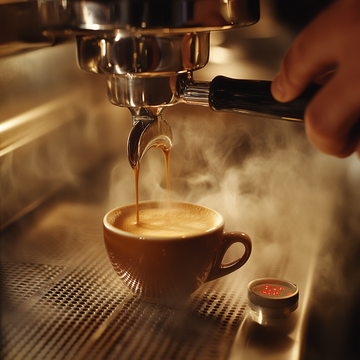Ever seen a barista pull an espresso shot that looks so smooth, rich, and perfect you could almost taste it just by watching? That golden crema, the deep aromas, the way it flows into the cup — it’s pure magic in motion. But here's the truth: making that flawless shot at home? It's not just magic. It takes a little know-how, some trial and error, and yeah, a bit of patience. But don’t worry — with the right tips and a little practice, you'll be pulling shots like a pro in no time.
Whether you’ve never pulled a shot in your life or you’ve been trying for a while and want to perfect it, this guide’s got your back. By the time we’re done, you’ll not only know how to make that perfect espresso, but you’ll understand why each little step counts. Ready to dive in? Let’s get brewing!
The Art of Espresso:
Espresso isn’t just coffee — it’s an experience. And like any great experience, it all comes down to precision. You’ve got a small, concentrated shot of coffee, so every detail matters. The grind, the dose, the tamp, and even the time you brew — it all plays a part in creating the perfect shot. It may sound like a lot to juggle, but once you break it down, it’s really about finding the balance.
There are three key ingredients to a great espresso: dose, yield, and time. If any of these are off, your shot won’t be quite right. Too much coffee? It’ll be bitter. Too little? Weak and sour. But when everything’s balanced just right? You get that smooth, rich, perfectly extracted shot. And once you’ve nailed these, consistency is the name of the game.
Don’t worry if your first few attempts aren’t perfect — every shot is a step closer to getting it just right.
Step 1: Get the Dose Right
Let’s start with the dose. This is the amount of coffee you’ll use. For a single shot, you’ll need 7–10g of coffee. For a double shot, it’s around 16–18g, and for a triple, you’re looking at 20–22g. Now, it might be tempting to eyeball it — but trust me, using a scale is the best way to ensure consistency. A tiny difference in dose can have a big impact on your shot, and consistency is key when you’re perfecting your brew.
Step 2: Nail the Yield
Next, let’s talk about yield — how much espresso you want in your cup. The general rule is a 1:2 ratio — so if you use 18g of coffee, you should aim for 36g of espresso. This 1:2 ratio is the recommended guideline by the Specialty Coffee Association (SCA), which ensures you get a balanced shot every time. But hey, don’t feel stuck with the rule — some people go for a 1:1.5 ratio, like 20g in and 30g out. Play around and find the ratio that works for you. It’s all about discovering your own perfect cup.
Step 3: Timing Is Everything
Timing — now, this is where the magic happens. You want your shot to pull for around 25–30 seconds. If it’s taking longer, it could be over-extracted (and bitter). If it’s too quick, it’s under-extracted and will taste sour. Don’t stress if it doesn’t work out at first — this is where your grind size comes into play.
A finer grind will slow things down, giving the water more time to extract flavor. A coarser grind will speed things up. It might take a few tries to get the timing just right, but once you’ve got it, you’ll know.
Step 4: Get the Technique Down
Distribute Evenly: Before tamping, it’s crucial to distribute your grounds evenly. If you don’t, the water will flow through the coffee unevenly, leading to an uneven extraction. A simple tap on the portafilter or a little swirl will do wonders here. It’s a small move, but it can make a big difference in the final taste.
Tamp Like a Pro: Next comes the tamp. You want to apply about 30 pounds of pressure — think firm, not crazy. No need to flatten the coffee grounds like you’re pushing dough down for pizza. Just steady, even pressure to make sure the coffee is compressed properly. This is key to ensuring the water flows through the coffee evenly.
Step 5: Pull the Shot
You’re almost there! Now, lock your portafilter into the machine and start the shot. Start the timer as soon as the shot begins and keep an eye on the scale. Once you hit your target weight (around 36g for a double shot), stop the shot, and check the time. Ideally, it should fall between 25 and 30 seconds. If it’s too fast or too slow, adjust your grind, dose, or tamp until you find the right balance.
So What Happens if It Doesn’t Go Right?
It’s totally normal for your first few shots to go awry — don’t get discouraged! If your shot pulls too fast, your grind might be too coarse. If it’s too slow, it’s probably too fine. And honestly, tasting your shot is the best way to learn. If it’s not quite right, take notes, make adjustments, and try again. It’s all about experimenting until you find that perfect shot.
Practice Makes Perfect
Don’t expect to become an espresso expert overnight. Every shot you pull is a chance to learn, tweak, and improve. And once you’ve perfected your espresso, you can dive into even more fun stuff like steaming milk for lattes or trying your hand at latte art. There’s always something new to discover in the world of coffee.
So grab your beans, get brewing, and most importantly — enjoy the process. Coffee is a journey, not a destination.


